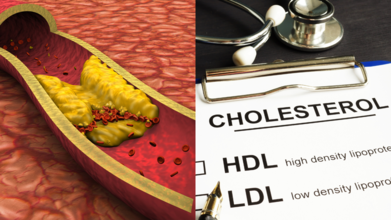- Health Conditions A-Z
- Health & Wellness
- Nutrition
- Fitness
- Health News
- Ayurveda
- Videos
- Medicine A-Z
- Parenting
- Web Stories
International Yoga Day: Can Yoga Be The Antidote To Rising Teen Anxiety?

Observed every year on June 21st, International Yoga Day is more than a holiday honoring a health practice. It emphasises the numerous benefits of yoga for personal wellness and mindfulness, urging individuals to embrace calm amidst chaos. The age-old practice of yoga can perhaps provide young minds with a means to reboot and recall inner peace.
With teen anxiety on the increase, yoga is now being hailed not only as a means of physical exercise, but also as an intervention in mental health that can assist teens to manage emotional stress.
The Mental Health Crisis Among Teens
According to Dr. Namrata Mahajan, Counselling Psychologist & Special Educator at Artemis Hospitals, teen mental health has deteriorated significantly in recent years. "Since technology and social media became a big part of everyday life, many teens now spend hours looking at perfect pictures of themselves online, which can make them feel bad about themselves and more anxious," she explains.
Increased screen time, cyberbullying and unrealistic comparisons have led to disrupted sleep patterns, mood swings, and heightened levels of anxiety. Add to that the pressures of academic achievement, extracurricular demands and college applications and you have a complex emotional landscape.
"Many teenagers find themselves losing their sense of independence and belonging due to factors like overprotective parents, peer pressure, and bullying," Dr. Mahajan adds. The need for holistic, non-invasive tools to support their mental well-being has never been more crucial.
Rima Bhandekar, Senior Psychologist, Mpower adds in and explains, "Yoga is an accessible, practical tool that complements therapy and medication, but isn’t a magic fix. Yoga provides an effective psychological support by training the minds of the teens to live in the present moment. It can promote a sense of control, as some of the techniques like breath control and stretches can be done anytime, anywhere, which reduces the feelings of helplessness in the moment that is associated with anxiety."
What Are The Underlying Psychological And Social Triggers Behind Anxiety Among Teenagers?
There has been a rise in teen anxiety and depression in India over the past decade, with a further increase during and after the COVID-19 pandemic, due to academic performance pressure, parental expectations, and competition for limited opportunities. Teen brains have become overwhelmed with increased digital interactions, reduced self-care time, and less in-person connection with others.
Ms Rima points out, "Anxious teens often get caught in a cycle of unhelpful ways of thinking, and do not know how to calm themselves down effectively. This can cause them to avoid things, get easily upset, pull away from others, or even have panic attacks. For example, they might think, “If I don’t do well in life, I’m letting my family down,” or see things in all good or all bad light, like “I’m either best in my class or worthless.” They are likely to personalize their problems, might think like, “If my loved one is unhappy, it must be solely my fault.” These thoughts increase anxiety, making teens feel trapped in a cycle of self-blame and believing that one mistake will ruin everything they worked hard for."
How Yoga Impacts The Body Biologically?
Yoga isn’t just a spiritual or philosophical endeavor; it has tangible physiological effects on stress regulation. Dr. Mahajan explains that consistent practice can regulate cortisol levels, improve heart rate variability (HRV), and enhance sleep cycles in teenagers.
"Yoga helps lower cortisol levels, which helps calm emotional turbulence. It increases HRV, indicating better resilience and heart health by activating the parasympathetic nervous system. Yoga also boosts melatonin production, aiding restful sleep," she says.
These biochemical shifts translate into better emotional regulation, sharper focus, and a stronger sense of well-being for adolescents. The simplicity and accessibility of yoga make it an appealing choice for schools, homes, and community spaces.
According to Jyoti Singh, yoga expert and Founder & CEO of Sparsh Yog, yoga is a gentle but effective way to support teenagers through emotional turbulence. "When a teenager practices yoga, their body shifts from a stressed 'fight or flight' state to a relaxed 'rest and digest' mode," she explains.
This change is crucial for reducing anxiety. Yoga practices improve vagus nerve function, connecting the brain and body, and promoting emotional stability. Importantly, the practices don’t need to be complex.
Jyoti recommends, "Asanas like Balasana (Child’s Pose), Viparita Karani (Legs-Up-the-Wall), and Setu Bandhasana (Bridge Pose) and Pranayama such as Anulom Vilom (Alternate Nostril Breathing) and Bhramari (Bee Breath). Meditation, including mindful breathing or silent mantra chanting."
"These simple techniques bring calm, clarity, and confidence. I have seen teenagers grow emotionally stronger and more grounded through yoga," Jyoti adds.
"Yoga teaches teens to lean towards more compassion towards self and higher mental fitness, which further equips them to handle life’s challenges. Instead of reacting, teens learn to mindfully choose to act on daily living pressures by embracing uncomfortable thoughts, breathing through tough emotions, and connecting to the present moment, which builds emotional flexibility in the person. Yoga teaches to observe their anxious thoughts without labeling them, accepting them instead of suppressing or getting upset by them," says Ms Rima.
Balancing the Doshas Through Yoga
Acharya Shiv, a Yoga and Meditation expert, brings an Ayurvedic perspective to teenage anxiety. "In teens, the Pitta Dosha is dominant—symbolizing intensity, ambition, and heat. Combined with Kapha growth energy, it creates an inner fire that lacks direction," he says.
"Kapha is making them grow, that means their bones are still growing, their brain is still growing. So, in that case, I always say this to my clients and even to the students that start working on three simple pranayamas, three simple pranayamas and three postures which are extremely important for children especially and the young kids which are growing up and the youth," adds Acharya.
Yoga Asanas Effective For Teenagers
Acharya Shiv emphasizes the importance of targeted yoga routines for teens to regulate this internal imbalance. He recommends three asanas:
Veer Bhadrasana (Warrior Pose) – "It stills the body, stabilizes the heart rate, and grounds mental energy."
Balasana (Child’s Pose) – "Encourages blood flow to the brain, inducing relaxation and releasing negativity."
Matsyendra Asana (Half Lord of the Fishes Pose) – "A twisting pose that supports digestive health and the Manipura Chakra, helping teens tap into their intuition."
For pranayama, he advises:
Nadi Shodhan (Alternate Nostril Breathing) to balance the nervous system
Bhramari (Bee Breath) to quiet racing thoughts
Om Chanting for emotional purification and self-expression
"Om chanting alone can improve serotonin levels, lower cortisol, and ease anxiety-induced stuttering. It builds confidence and self-awareness," he adds.
Yoga is more than just stretching or deep breathing, it cultivates emotional literacy, helping teens identify, understand, and manage their feelings. Regular practice encourages mindfulness, fosters a sense of self-compassion, and creates a safe mental space where teens can reflect without judgment.
Yoga teaches adolescents to pause before reacting, an essential skill in emotionally charged situations. It improves attention span, reduces impulsivity, and helps young people navigate both internal and external challenges with greater poise.
Acharya Shiv emphasizes, "Teenage kids will be able to express themselves a lot better if they learn to inculcate yoga in their daily routine. I get a lot of patients who come with a problem of stuttering, children come with a problem of stuttering because they were facing anxiety. Now the moment they start doing 10-15 rounds of Om chanting, they see a huge difference in their thinking process you can say and also they could express themselves better because they were loudly chanting Om."
How Schools and Parents Can Integrate Yoga Into Teens' Lives?
Given its proven benefits, schools and parents have a vital role to play in making yoga more accessible. Morning yoga sessions, after-school yoga clubs, and even five-minute breathing breaks during class can make a profound difference.
Parents can encourage short, home-based practices, perhaps joining in themselves to model behavior. Apps, guided videos, and local community centers also offer free or low-cost ways to start.
Creating non-competitive, judgment-free yoga spaces where teens can simply show up and be present without fear of performance or appearance tanyais key to long-term engagement.
As teen anxiety continues to rise globally, yoga stands out not only as a therapeutic tool but also as a preventive practice. Unlike medication or therapy, which may come with stigma or side effects, yoga offers a natural, empowering, and holistic path to emotional stability.
On this International Yoga Day, we are reminded that some of the oldest solutions remain the most effective. For teens drowning in a sea of stress, yoga may just be the anchor they need.
Yoga can help teens who are getting more anxious. Yoga helps relax the nervous system, lower stress chemicals like cortisol, and make you stronger emotionally by focusing on breathing, moving, and being present. Yoga provides a calm place for adolescents to reset when they are feeling overwhelmed by schoolwork, social media, or their own feelings. This mind body exercise promotes equilibrium over time, not just in your body but also in your thoughts.
Is Your Daily Routine Silently Raising Your Cholesterol? Here is How to Lower It

Credits: Canva
You cannot see it, feel it, or hear it increasing, but cholesterol might be quietly present in your bloodstream, creating trouble for your heart. Your everyday habits, like late-night scrolling, snack-bingeing, or skipping workouts, could be some of the reasons.
Experts warn that ignoring cholesterol is not a wise idea. “High cholesterol is not always easy to spot, and your everyday habits could be quietly leading to it. Making small, steady changes can really help your heart stay healthy,” explains Dr Vikas Vashisth, MD, Internal Medicine, SilverStreak Multispeciality Hospital.
We turn to experts to know what causes bad cholesterol and, more importantly, how you can lower it.
Rethink Your Fats
Fried food might taste divine, but they are not doing your heart any favours. Foods high in saturated fats, like red meat and full-fat dairy, increase LDL (the “bad” cholesterol). Trans fats, lurking in packaged snacks and baked goodies, are equally problematic.
“Go for healthier fats instead,” advises Dr Vashisth. Like olive oil for your cooking, a handful of nuts for your 4 pm cravings, or avocado on toast.
Increase Fibre Intake
If there is one thing that helps fight cholesterol, it is soluble fibre. Found in foods like oatmeal, apples, pears, kidney beans, and even Brussels sprouts, fibre acts like a sponge, soaking up cholesterol and flushing it out.
“Try to get 5 to 10 grams of soluble fibre every day to lower LDL cholesterol,” says Dr Vashisth. And no, that does not mean buying ‘fibre-rich’ biscuits; stick to whole, natural foods.
Sweat It Out
HDL is the “good” cholesterol that protects your heart. Exercise boosts HDL while lowering LDL, making it a double win. “Aim for at least 30 minutes of moderate activity most days,” suggests Dr Vashisth. Brisk walks, cycling, swimming, or even a dance session in your living room can do the trick.
Pick Heart-Healthy Foods
Food can be medicine if chosen wisely. Omega-3 fatty acids found in salmon, mackerel, walnuts, and flaxseeds help lower triglycerides and blood pressure. You can also try plant sterols or stanols (often in fortified foods) that block cholesterol absorption. Consider them little bodyguards in your kitchen.
Keep an Eye on the Scales
Carrying extra weight does not just sit on your waistline; it affects your cholesterol, too. “Even small changes in weight can have a positive impact,” says Dr Vashisth. Balance your meals, cut back on sugar-loaded snacks, and stick to consistent movement. Think of it as housekeeping for your health.
Why Indians Need to Pay Extra Attention
Most people imagine cholesterol to be a “Western problem”. But Indians are at higher risk of heart disease at younger ages. “We develop heart disease earlier due to a distinctive pattern of dyslipidaemia—high triglycerides and small, dense LDL particles,” warns Dr Honey Sharma, Consultant, Interventional Cardiology, Shalby Hospital.
On top of that, some people have genetically high cholesterol, making monitoring all the more vital. Dr Sharma stresses that guidelines by the Cardiological Society of India recommend stricter cholesterol targets than Western populations.
Habits That Raise Cholesterol
Not all cholesterol triggers are obvious. According to Dr Sharma, your everyday choices might be the stealthy culprits:
- Poor Sleep: Burning the midnight oil raises cortisol, which spikes cholesterol. Target at least 7 hours of shut-eye.
- Inactivity: Long hours at the desk lower HDL. Stand, stretch, or walk every hour.
- Chronic Stress: Stress pushes your liver to churn out cholesterol. Counter it with yoga, journaling, or short breaks.
- Sugar Overload: Beware of “low-fat” snacks that hide sugar. They raise triglycerides. Instead, choose fruit, nuts, or homemade curd.
Simple Fixes That Actually Work
You do not need a total lifestyle makeover. Start with tiny swaps:
- Eat more greens, legumes, and fruits.
- Walk, cycle, or dance daily.
- Replace stress scrolling with music, meditation, or journaling.
- Snack smart: pick seeds, roasted chickpeas, or fresh fruit.
What Is Frontotemporal Dementia That Psychologists Claim Donald Trump Is Exhibiting Signs Of?

Credits: realdonaldtrump/Instagram, Canva
Donald Trump’s health has once again become a hot talking point, but this time it is not about his diet or late-night Twitter habits. Instead, two psychologists are raising red flags about something far more serious: dementia. According to them, the US president has been showing what they describe as a “dead ringer telltale sign” of frontotemporal dementia (FTD) and they warn that the symptoms appear to be getting “worse and worse”.
The psychologists’ concern
Clinical psychologists Dr. Harry Segal and Dr. John Gartner, hosts of the podcast Shrinking Trump, claim that Trump’s psychomotor functioning has visibly deteriorated. Speaking to The Guardian, Dr. Gartner said, “Some of the more evidence that we've been talking about recently has been his psychomotor performance, that we're seeing a deterioration in his motor performance, which also goes with dementia because with dementia there's a deterioration of all faculties, all functions.”
Adding to the intrigue, the Mirror reported that Trump has been spotted “frantically” trying to hide the back of his hand, fuelling speculation about his health. According to Dr. Gartner, Trump’s verbal slips, struggles with language, and now motor difficulties fit the pattern of a neurodegenerative disorder. He even suggested Trump may have more than one form of dementia, but he believes one stands out: frontotemporal dementia.
“One of the things that one of the neuropsychologists that we were working with last year pointed out that is almost a dead ringer telltale sign of frontotemporal dementia is something they call a wide-based gait, where you have a sort of one of your limbs, one of your legs, and you kind of swing it in a semicircle,” Dr. Gartner explained.
What exactly is frontotemporal dementia?
Frontotemporal dementia (FTD) is not a single disease but a group of disorders that attack the brain’s frontal and temporal lobes. These regions control personality, social behaviour, and language, the very things that often change first in people with the condition.
Unlike Alzheimer’s disease, which is better known, FTD often shows up earlier, typically between the ages of 40 and 65. However, it can appear later in life, making it tricky to diagnose. Many patients are first misdiagnosed with psychiatric conditions or even Alzheimer’s because the symptoms overlap.
Symptoms that raise eyebrows
The Mayo Clinic states that the symptoms of FTD vary depending on the most affected part of the brain. The progression is gradual but relentless.
Behavioural symptoms include:
- Socially inappropriate behaviour.
- Loss of empathy and sensitivity to others.
- Poor judgement and impulsivity.
- Apathy that can be mistaken for depression.
- Compulsive habits such as tapping, clapping, or repetitive lip-smacking.
- Decline in hygiene.
- Odd eating habits – from sudden sugar cravings to chewing on non-food items.
Language-related symptoms include:
- Trouble understanding and producing speech.
- Difficulty finding the right words.
- Using vague terms like “it” instead of specific words.
- Simplified, telegraphic speech.
- Errors in building sentences.
Movement-related symptoms (less common but significant) include:
- Tremors, stiffness, or muscle spasms.
- Difficulty swallowing or weakness.
- Poor balance leading to falls.
- Inappropriate emotional outbursts like laughing or crying.
The “wide-based gait” noted by Dr. Gartner falls into this movement-related cluster, aligning with the suspicion of FTD.
What causes it?
FTD literally shrinks the brain; the frontal and temporal lobes undergo atrophy while abnormal proteins accumulate. The precise cause is not always clear, but genetics plays a role in some cases. Mutations in certain genes overlap with conditions like ALS (amyotrophic lateral sclerosis), hinting at a deeper biological link that scientists are still trying to untangle.
Interestingly, over half of people diagnosed with FTD have no family history of dementia, meaning the condition can strike seemingly out of the blue.
Who is at risk?
The only established risk factor is family history. Unlike heart disease or type 2 diabetes, lifestyle choices have not been clearly tied to developing FTD. Still, because it often appears earlier than Alzheimer’s, it can be devastating for families, robbing individuals of their personality, judgement, and communication skills during what should be the prime of life.
While Trump’s team has not confirmed or denied any health concerns, the observations of Dr. Segal and Dr. Gartner point to a broader issue: recognising the early signs of dementia in public figures and ordinary people alike. If the psychologists are correct, the president may be experiencing symptoms that fit squarely within the profile of frontotemporal dementia.
What is Bruce Willis's health update? He was also diagnosed with FTD over three years ago
Bruce Willis Health Update: Besides Trump's news, there is an update on Bruce Willis's health. At the preview of ABC's special Emma & Bruce Willis: The Unexpected Journey, Willis' wife Emma opened up about her husband's battle with frontotemporal dementia, saying his “brain is failing him” and his “language is going.” Despite the heartbreaking progression of the disease, she says their family has found new ways of communicating and cherishes the rare moments when his true personality shines through.
The 70-year-old “Die Hard” and “Sixth Sense” star was diagnosed with frontotemporal dementia more than three years ago. In 2023, his family revealed the condition.
You Will Be Surprised: THIS Chronic Condition Could Be the Hidden Reason You Cannot Conceive

Credits: Canva
When couples struggle to conceive, they usually think of hormone imbalances, advancing age, or lifestyle problems. But did you ever imagine that the real hindrance could be something as silent as chronic inflammation? It does not make headlines like PCOS or low sperm count, yet it silently disrupts the reproductive system in both men and women. And yes, it could be standing between you and your dream of parenthood.
Inflammation is More Than Just Swelling
Dr. Rupali Tambe, Fertility Specialist at Nova IVF Fertility, Lullanagar, explains that chronic inflammation is increasingly being linked to infertility. “Some conditions, such as infections, endometriosis, and polycystic ovary syndrome (PCOS), are marked by inflammation. This can impact the uterus and cervix, ultimately reducing the chances of conception,” she says.
Inflammation is like the body’s fire alarm. It is helpful when you have hurt yourself or caught an infection. But when the alarm does not switch off, the body is stuck in a low-level state of stress, which can interfere with ovulation, sperm production, and even implantation.
The Science of Why It Affects Fertility
According to Dr. Mandavi Rai, Senior Fertility and IVF Specialist at Motherhood Fertility & IVF, Noida, the trouble goes deeper than you think. “Chronic inflammation due to conditions like PCOS, autoimmune diseases, poor diet, or stress can impact the ovaries, fallopian tubes, and uterus in women. In men, it damages sperm production, count, and motility,” she points out.
For women, this could mean poor egg quality, scarring of the fallopian tubes due to pelvic inflammatory disease or endometriosis, or hormonal imbalances that block ovulation. For men, issues like orchitis (testicular inflammation) or varicocele (enlarged veins in the scrotum) can heat things up. Higher testicular temperature disrupts sperm formation, leaving fewer healthy swimmers.
Can Diet Calm the Fire?
You do not have to live with inflammation forever. Dr. Tambe says that studies suggest an anti-inflammatory diet may boost pregnancy rates in women and even improve sperm quality in men.
An anti-inflammatory diet would include foods like salmon, walnuts, flaxseeds, berries, mushrooms, leafy greens, tomatoes, yoghurt, and even kimchi. Avocados, turmeric, ginger, kale, and green tea also make the cut. These foods are packed with antioxidants and healthy fats that cool inflammation naturally.
And Dr. Tambe advises skipping processed, fried, and sugary foods. That means saying no to French fries, pizzas, pastries, namkeens (salty mixtures), and fizzy drinks. Basically, if it comes in a packet or is dripping with oil, it is not doing your fertility any favours.
Beyond Food Choices
Food is not the only reason here. Dr. Rai stresses that daily exercise, quitting smoking and alcohol, and maintaining a healthy weight are essential. “Regular activities like swimming, cycling, or yoga reduce inflammation markers in the body and improve reproductive health,” she says.
Do not forget stress. Chronic stress itself is a proven inflammation trigger. Meditation, deep breathing, or just unplugging from your phone for an hour a day can help quiet your nervous system. And yes, quality sleep, at least 7 to 8 hours, acts as nature’s best anti-inflammatory pill.
When Lifestyle Changes Aren’t Enough
Sometimes, lifestyle fixes and diets cannot tackle severe inflammation. That is when medical interventions step in. Non-steroidal anti-inflammatory drugs (NSAIDs), antibiotics (for infections), or hormonal treatments may be prescribed by specialists.
For couples facing stubborn infertility, assisted reproductive technologies (ART) like IVF or ICSI can provide hope. “Women with infertility who followed an anti-inflammatory diet during IVF had better pregnancy outcomes compared to those who didn’t,” Dr. Tambe says.
Infertility is rarely caused by a single factor, but chronic inflammation is an under-recognised condition. The right mix of an anti-inflammatory diet, lifestyle changes, and expert care can make all the difference.
© 2024 Bennett, Coleman & Company Limited

